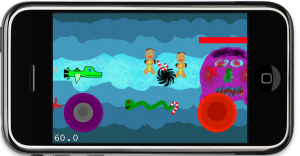I’m back from Macoun, and it was nice meeting you all! Well, actually since that conference was just a 90 minute ride away, so I wasn’t really gone, except mentally. I spent a lot of time last week to prepare my presentation (in german), and fighting a cold. The subject was a game component system that I wrote on top of cocos2d, to encapsulate most of the cocos2d CCNode stuff and allowing me to focus on writing re-usable gameplay components. The system works but it’s not production tested. Still it’s proven very promising from my initial tests and opens some interesting opportunities, for example the re-use of components is a huge timesaver, and you can totally get rid of any class hierarchy and remain flexible throughout development. Due to writing the book and other things I hadn’t had the time to develop it as much as I wanted to. I’ll release it eventually but for the moment, I have a different focus.
For one, I’m late with the Game Center chapter due to the Macoun conference preparations, an upcoming wedding and an apartment renovation of the soon-to-be-wed as their wedding gift. So I’ll try to cram writing both the Game Center chapter and the final chapter in this week, before turning my attention to updating the Line-Drawing Starterkit and Xcode project. I did not intend to support non-beta versions of cocos2d, but given how long the recent betas last and how many developers actually use the latest beta (probably due to HD support) and how significant the breaking changes are this time, I’m going to update the starterkit and Xcode project with HD support while keeping the old project for those who would rather use the stable 0.99.4 version of cocos2d. Once that’s done, it’ll be mid of October and another project, only partly concerning cocos2d, kicks in full speed. No time to lose.
Speaking of the Starterkit, September went by and I made 10 sales, without advertising it or anything, so those numbers are at the lower end of the “potential sales” spectrum. That’s a sum (over $1,500) that I can live with. Well, actually, that’s a sum that I can live off of. On a related matter, I recently found a page detailling the traffic stats of the cocos2d-iphone.org website. If those stats are correct, the unique visits are over ten times that of my site. Now, frankly speaking, every time I get those little facts and stats from here and there over the past couple months, and then added up the numbers, compared them with mine, applied reasonably pessimistic estimations and caution, I do wonder: why the hell isn’t cocos2d run like a business?
If you ask me, with those traffic stats and a reasonable conversion rate of 0.1% per unique visitor (mine is over 0.2%), one could easily pay 3 people to develop cocos2d, test it, write documentation, moderate the forum, and in general adding more business value. Which in turn grows the business, speeds up the development of the engine, tools and by-products and will make everyone benefit from that. I don’t get it. Because at this point, it’s either going to be that, or a slow decline to a niche product over the next couple years due to the increasingly strong competition from other iOS engines. Especially those that offer cross-platform support, since that’s what contractors are asking for, or even demanding, more and more.
Anyhow, for my part, I decided that now would be a good time to start doing the Indie thing full-time, still accepting contract work but I’m able to be a lot pickier about it. I have a goal set out for myself, and it’s not a simple one. I’ve always enjoyed most to help my colleagues, to fix their problems, to support them and in general, to help them achieve excellence. I know, that sounds like something you’d find in EA’s job matrix - and in fact, you do. Helping others achieve excellence, throughout my professional career, that’s what I’ve been doing and enjoying the most. Now I find myself doing that for cocos2d developers, enjoying it and being able to support myself in the process. Well, I think I’ll have to thank you, my dear readers, for that. 
As a thank you back, I’ve started working on a bigger project about 3 months ago that will be useful and helpful to many indie game developers, regardless of the engine you may be using. Hence it deserves its own website and a cool name (darn, that is hard!). I’m looking forward to really getting into high gear with it after I’ve submitted the remaining book chapters. Stay tuned.













